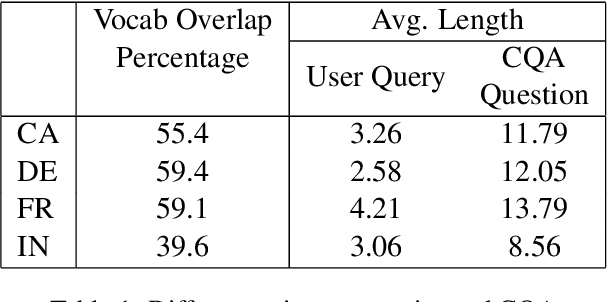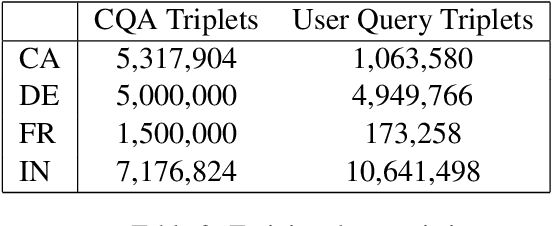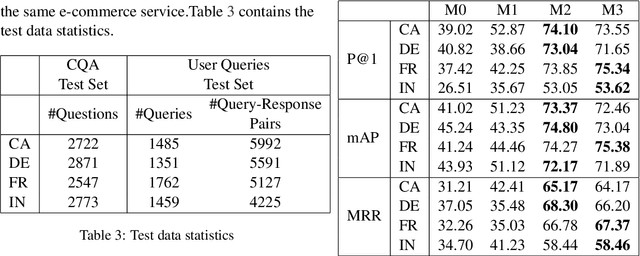Aniket Chakrabarti
Distantly Supervised Transformers For E-Commerce Product QA
Apr 07, 2021



Abstract:We propose a practical instant question answering (QA) system on product pages of ecommerce services, where for each user query, relevant community question answer (CQA) pairs are retrieved. User queries and CQA pairs differ significantly in language characteristics making relevance learning difficult. Our proposed transformer-based model learns a robust relevance function by jointly learning unified syntactic and semantic representations without the need for human labeled data. This is achieved by distantly supervising our model by distilling from predictions of a syntactic matching system on user queries and simultaneously training with CQA pairs. Training with CQA pairs helps our model learning semantic QA relevance and distant supervision enables learning of syntactic features as well as the nuances of user querying language. Additionally, our model encodes queries and candidate responses independently allowing offline candidate embedding generation thereby minimizing the need for real-time transformer model execution. Consequently, our framework is able to scale to large e-commerce QA traffic. Extensive evaluation on user queries shows that our framework significantly outperforms both syntactic and semantic baselines in offline as well as large scale online A/B setups of a popular e-commerce service.
ColdRoute: Effective Routing of Cold Questions in Stack Exchange Sites
Jul 02, 2018



Abstract:Routing questions in Community Question Answer services (CQAs) such as Stack Exchange sites is a well-studied problem. Yet, cold-start -- a phenomena observed when a new question is posted is not well addressed by existing approaches. Additionally, cold questions posted by new askers present significant challenges to state-of-the-art approaches. We propose ColdRoute to address these challenges. ColdRoute is able to handle the task of routing cold questions posted by new or existing askers to matching experts. Specifically, we use Factorization Machines on the one-hot encoding of critical features such as question tags and compare our approach to well-studied techniques such as CQARank and semantic matching (LDA, BoW, and Doc2Vec). Using data from eight stack exchange sites, we are able to improve upon the routing metrics (Precision$@1$, Accuracy, MRR) over the state-of-the-art models such as semantic matching by $159.5\%$,$31.84\%$, and $40.36\%$ for cold questions posted by existing askers, and $123.1\%$, $27.03\%$, and $34.81\%$ for cold questions posted by new askers respectively.
* Accepted to the Journal Track of The European Conference on Machine Learning and Principles and Practice of Knowledge Discovery in Databases (ECML PKDD 2018); Published by Springer: https://link.springer.com/article/10.1007%2Fs10618-018-0577-7
Fast Change Point Detection on Dynamic Social Networks
Jun 04, 2017



Abstract:A number of real world problems in many domains (e.g. sociology, biology, political science and communication networks) can be modeled as dynamic networks with nodes representing entities of interest and edges representing interactions among the entities at different points in time. A common representation for such models is the snapshot model - where a network is defined at logical time-stamps. An important problem under this model is change point detection. In this work we devise an effective and efficient three-step-approach for detecting change points in dynamic networks under the snapshot model. Our algorithm achieves up to 9X speedup over the state-of-the-art while improving quality on both synthetic and real world networks.
 Add to Chrome
Add to Chrome Add to Firefox
Add to Firefox Add to Edge
Add to Edge